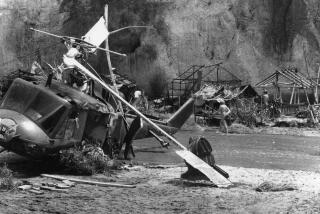Justices Hear Case Involving Media and Privacy Issues
- Share via
SACRAMENTO — California Supreme Court justices, considering whether a television broadcast violated an accident victim’s right to privacy, appeared troubled Tuesday over media tactics but reluctant to restrict coverage of newsworthy events.
Ruth Shulman of Palos Verdes sued Group W Productions after her 1990 car accident was featured on a now defunct, syndicated show called “On Scene: Emergency Response.” The accident left Shulman a paraplegic.
The program showed Shulman pinned under her family’s overturned car, her legs sticking out, in a ditch alongside a freeway. The paramedic who tended her wore a cordless microphone, and viewers could hear Shulman moan and urge the rescue worker to let her die.
The court will decide within 90 days whether Shulman can sue the broadcaster for taping her at the scene and inside a helicopter ambulance without her knowledge. The case is one of several disputes that have come up in courts nationwide involving the media’s use of hidden microphones and programs in which reporters ride along with law enforcement or rescue personnel.
During oral arguments in Sacramento, some of the justices seemed concerned by the media’s behavior in the case. Just because the woman had a car accident, are “her personal life and her emotions open season?” asked Justice Kathryn Mickle Werdegar.
Kelli Sager, representing Group W, told the court that the media should be free to report matters of public interest as long as the reports are accurate.
Members of the court seemed to accept that the broadcast was a matter of public interest and some expressed skepticism that the accident victim was hurt by the report. But the justices also appeared hesitant to give the media total freedom in such situations.
A Court of Appeal in Los Angeles decided that Shulman had no privacy right at the accident scene but could sue the broadcast company for showing her inside the helicopter as she was being flown to a hospital.
The appeals court said a jury should decide whether the helicopter segment was offensive and whether the intrusion was outweighed by the accident’s newsworthiness.
Shulman wants the state high court to rule that she also had a privacy right at the accident scene. On the other side, media lawyers are asking the court to reject any sort of balancing test for determining when reports violate another’s privacy rights.
The outcome is expected to affect not only tabloid “ride-along” shows that depict real people and events but also investigative reports that deploy hidden cameras. Media lawyers fear that a broad ruling could even restrict the ability of print media to cover stories.
Chief Justice Ronald M. George appeared to side with the media, stressing that Shulman could not be identified in the broadcast. An oxygen mask obscured her face, and she was referred to only by her first name.
“How will anyone know who she is?” George asked.
Antony Stuart, a lawyer for Shulman, told the court that her voice is distinctive and was easily recognized by acquaintances who saw the show. He said Group W, which was acquired by CBS, exploited Shulman for “purely entertainment value.”
Although the accident scene was not private, Shulman had a reasonable expectation that the words that she uttered there would not be broadcast to millions of strangers, Stuart contended.
“There is no social value to hearing a human being’s emotional reaction to having her spinal cord severed,” he said.
Sager noted that the media have a legal right to go to scenes of accidents and disasters and that Shulman’s words to the paramedic could have been overheard by others at the scene.
Werdegar, however, drew a distinction between the kinds of media coverage that accident victims might reasonably expect. Although a victim might anticipate being photographed, he or she would not expect that a paramedic would be wearing a microphone and recording conversations, Werdegar said.
Several justices asked the lawyers whether the timing of the program should be a factor in the court’s decision. The episode on Shulman ran three months after the accident.
“If an event is newsworthy at the time it happens, is it forever newsworthy?” Justice Stanley Mosk asked.
Sager replied that the law suggests newsworthiness persists. “The mere passage of time does not convert something that was newsworthy into something that was not,” Sager said.
More to Read
Get the L.A. Times Politics newsletter
Deeply reported insights into legislation, politics and policy from Sacramento, Washington and beyond. In your inbox twice per week.
You may occasionally receive promotional content from the Los Angeles Times.










